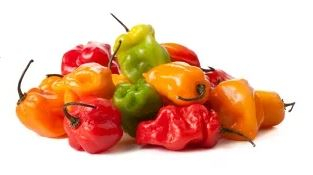
We collect basic website visitor information on this website and store it in cookies. We also utilize Google Analytics to track page view information to assist us in improving our website.
When Christopher Columbus showed up in what would become North America a few hundred years ago, he was hoping to find highly prized black peppercorns (as in the fresh cracked kind we use regularly as a condiment and for seasoning). Instead, the intrepid explorer got bell or sweet peppers, which are native to Central and South America. When he brought the fruit—and it is technically a fruit—back to Europe, it was called a pepper.
So, what we refer to as red, orange and green bell or sweet peppers are “capsicum annum,” not the hot and spicy “piper negrum,” or black pepper, which is originally from India; Columbus missed the mark by 10,000 kilometres. Yet, regardless of their heat level, sweet bell peppers and hot chile peppers are delicious and versatile.
Of course, bell peppers are not hot and spicy like many other peppers. They range in colours from red, yellow and orange, as well as slightly more unusual examples of brownish, lavender and white and purple variegated. However, the colours can be an indication of relative sweetness and bitterness: green peppers are the least sweet fruit and can be slightly bitter, while red peppers are sweetest. Of course, red peppers are just ripe green peppers, but there are varieties that remain permanently green.
In North America, capsicum fruits are often called “hot peppers.” We refer to chile peppers, which is a Spanish word, and the widely used American word chili, which refers to both the meat stew and the powder that is one of its ingredients. However, an ancient Nahuatl word, chilli, is probably the original word used to refer to peppers.
The crunch and freshness of a bell pepper is its own reward, but it does have the potential for a variety of cooking treatments. Simply roasting it on an open flame until it is charred and blistered black produces a delicious result: once charred, place the peppers in a bowl and cover to allow the heat to do its work and finish the cooking.
Bell peppers of any colour can be stuffed a variety of ways, from ground beef to eggs. A red pepper roasted and blended with a nut makes a great dip; add some harissa for a bit of Moroccan spice. Roasted or fresh, colourful peppers add a flavour dimension to salade niçoise, and roasted red pepper soup accepts multiple other flavourings and is a great starter for winter-weather dining.
It is a generally accepted classification that the smaller the chile pepper, the hotter it will be. For the most part—and to only a slight degree—a chile pepper’s heat can be reduced by removing the seeds during preparation. In the cases of even relatively mild jalapeño peppers, it is wise to use gloves when handling very hot peppers.
The plump and popular Jalapeño (which just loves to be stuffed with a wide range of ingredients) when smoked is known as a chipotle and often shows up in adobo sauce. This relatively mild pepper (about 7,000 SHU) can be added to salads, is great marinated and added to a variety of dishes.
Serrano peppers register at up to 25,000 SHU and can be red or green. They can go in gazpacho, guacamole, a slaw, pico de gallo or slivers garnishing salty prosciutto and honeydew crudites. You can also use them to flavour cooking and dressing oils.
The increasingly popular Chile de Arbol (up to 30,000 SHU) can be used fresh or dried and powdered. They contribute nicely to salsas and other sauces.
We usually see Cayenne pepper (up to 30,000 SHU) in its ground form. It is a quintessential spice and seasoning for Cajun dishes and foods of the U.S. south.
Tiny Thai chiles graphically support the “small-means-hot” rule: they clock in at up to 100,000 SHU. Thai chiles are most often found in southeast Asian dishes and curries.
A national roast chicken restaurant chain relies primarily on Piri Piri or Bird’s Eye Chiles (or more ominously African Devil) for its Portuguese inspired dishes. The small reddish chile originates in central African and registers at 175,000 SHU.
Often bright orange or yellow, the Habanero really starts to kick in with some serious heat at up to 325,000 SHU. It often is used to make hot sauces and is blended with tropical fruits like mango and lime.
The Habanero’s culinary relative is the Scotch Bonnet (again, about 325,000 SHU) which helps define Jamaican and Caribbean dishes like jerk chicken.
The Indian Ghost Pepper (Bhut Jolokia), Carolina Reaper and Dragon’s Breath have SHU readings in and around 1 million and even more. For any cooking application, they are just plain silly.
How hot is that pepper?

For example, a green bell pepper has a Scoville rating of zero, while a Habanero ranks at up to 325,000 Scoville Heat Units (SHU). At the hottest end, the Carolina Reaper pepper sits at over 1,000,000 SHU. That’s painful (and could even be lethal!).

